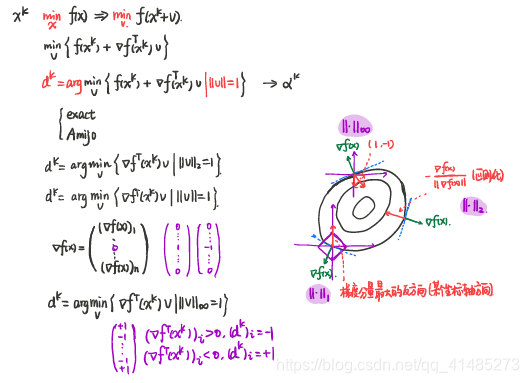中科大-凸优化 笔记(lec47)-最速下降法
本文共 520 字,大约阅读时间需要 1 分钟。
全部笔记的汇总贴(视频也有传送门):
一、梯度下降法
d k + 1 = − ∇ f ( x k ) f ( x k + 1 ) − P ∗ f ( x k ) − P ∗ ≤ 1 − m M ≤ 1 − min { 2 m γ α m a x , 2 m γ β M } K ∼ log ( f ( x k ) − P ∗ ) 线 性 收 敛 d^{k+1}=-\nabla f(x^k)\\\frac{f(x^{k+1})-P^*}{f(x^k)-P^*}\le1-\frac mM\le1-\min\{2m\gamma\alpha_{max},\frac{2m\gamma\beta}M\}\\ K\sim \log(f(x^k)-P^*)\;\;\;\;\;线性收敛 dk+1=−∇f(xk)f(xk)−P∗f(xk+1)−P∗≤1−Mm≤1−min{ 2mγαmax,M2mγβ}K∼log(f(xk)−P∗)线性收敛
二、最速(陡)下降法

三、Gradient与Steepest Gradient的变种
1)坐标轮换法

2)若 f ( x ) f(x) f(x)在某些点不可微

例:

下一章传送门:
转载地址:http://aepq.baihongyu.com/
你可能感兴趣的文章
nginx添加模块与https支持
查看>>
Nginx用户认证
查看>>
Nginx的location匹配规则的关键问题详解
查看>>
Nginx的Rewrite正则表达式,匹配非某单词
查看>>
Nginx的使用总结(一)
查看>>
Nginx的使用总结(三)
查看>>
Nginx的使用总结(二)
查看>>
Nginx的可视化神器nginx-gui的下载配置和使用
查看>>
Nginx的是什么?干什么用的?
查看>>
nginx看这一篇文章就够了
查看>>
Nginx简单介绍
查看>>
Nginx访问控制_登陆权限的控制(http_auth_basic_module)
查看>>
nginx负载均衡和反相代理的配置
查看>>
nginx负载均衡器处理session共享的几种方法(转)
查看>>
nginx负载均衡的5种策略(转载)
查看>>
nginx负载均衡的五种算法
查看>>
nginx转发端口时与导致websocket不生效
查看>>
Nginx运维与实战(二)-Https配置
查看>>
Nginx配置Https证书
查看>>
Nginx配置ssl实现https
查看>>